Maui is known as a romantic tourist getaway in beautiful nature, but is it a walkable destination? In this
Aloha and welcome to the beautiful island of Maui! As a traveler and long-time resident of Maui, I know that walking is one of the best ways to explore the island. But is Maui a walkable destination?
Spoiler alert: rent a car to get from town to town on Maui, then explore each area by foot. The island is approximately 48 miles long and 26 miles wide, with a total land area of 727.2 square miles, so unless you are feeling super ambitious and energetic and plan to stay on Maui for a few months, you are not going to want to walk your way across Maui.
In this article, we will explore the various factors that make a destination walkable and examine how Maui measures up. Whether you’re a first-time visitor or a seasoned traveler, you’ll learn everything you need to know about walking in Maui.
Cheat sheet of Maui towns rated for walkability:
| Town | Walkability | Highlights |
|---|---|---|
| Lahaina | Highly | Lahaina Historic Trail, shops, restaurants, attractions |
| Kihei | Moderately | Some sidewalks, pedestrian crossings, spread out in some areas |
| Paia | Very | Compact downtown, unique shops, restaurants, galleries, beach |
| Kahului | Moderately | Some sidewalks, pedestrian crossings, spread out in some areas |
| Wailea | Highly | Many shops, restaurants, attractions located within easy walking distance, Coastal Walk |
| Kapalua | Moderately | Some sidewalks, pedestrian-friendly crossings, hilly terrain in some areas |
Walkability factors:
When we talk about walkability, we are referring to several factors that make it easy and safe to walk around a city or town:
- pedestrian-friendly infrastructure,
- traffic flow, safety, and
- access to amenities.
On Maui, we have a unique mix of urban and rural areas, which can make walking challenging in some parts of the island.
Sidewalks: Many towns in Maui have sidewalks that are well-maintained and provide a safe space for pedestrians to walk. Not all areas have sidewalks, particularly in more rural or remote parts of the island, like the East side of Maui.
Crosswalks: Crosswalks are typically marked with painted lines and signage, but it’s important to note that not all drivers in Maui are accustomed to yielding to pedestrians. Visitors should use caution when crossing the street and be aware of their surroundings at all times.
Bike lanes: Maui has several bike lanes that provide a safe space for cyclists to ride. However, these lanes are not always separated from vehicle traffic, so visitors should use caution and be aware of their surroundings.
Crime rates: Tourists should be aware that while Maui is generally a safe destination for walking, crime can still occur. Use common sense and take basic safety precautions, such as staying in well-lit areas, walking with a friend or group, and avoiding isolated or unfamiliar areas. It’s always a good idea to carry a map or GPS device and be aware of one’s surroundings. Visitors to Maui can enjoy a safe and enjoyable walking experience by taking appropriate precautions and being aware of their surroundings.
While Maui may not have the same level of pedestrian infrastructure as larger cities, there are still many areas that are safe and enjoyable for walking. Visitors should always be aware of their surroundings and take necessary precautions to ensure their safety.
The walkability of Maui:
Maui is home to several towns and cities, each with its own unique character and walking opportunities. Lahaina, Kihei, Paia, Kahului, Wailea, and Kapalua are some of the most popular destinations for tourists. I will guide you through the characteristics of each town so you can make an informed decision about where to explore on foot:
Lahaina: definitely walk around this town
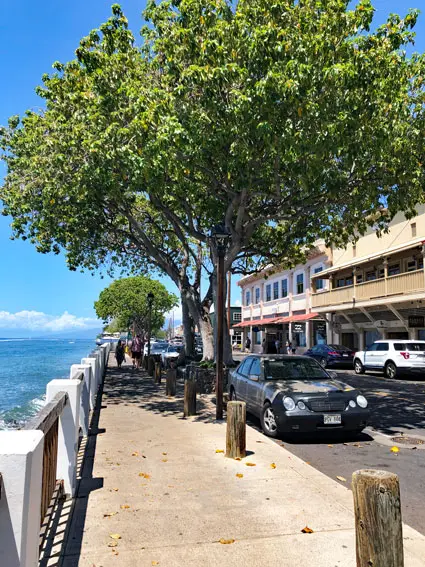
Lahaina is a historic town with a charming pedestrian-friendly center, making it a great destination for walking. Visitors can stroll along Front Street and explore the numerous shops, restaurants, and art galleries. Lahaina also offers access to several coastal walking trails, including the Lahaina Historic Trail and the Kapalua Coastal Trail. While some areas of Lahaina are walkable, the town is generally spread out and can be difficult to navigate on foot. Visitors should stick to the Lahaina Historic District, which features several pedestrian-friendly streets and is home to many of Lahaina’s top attractions, including the Baldwin Home Museum and the Wo Hing Museum.
Kihei: walkable beachside town
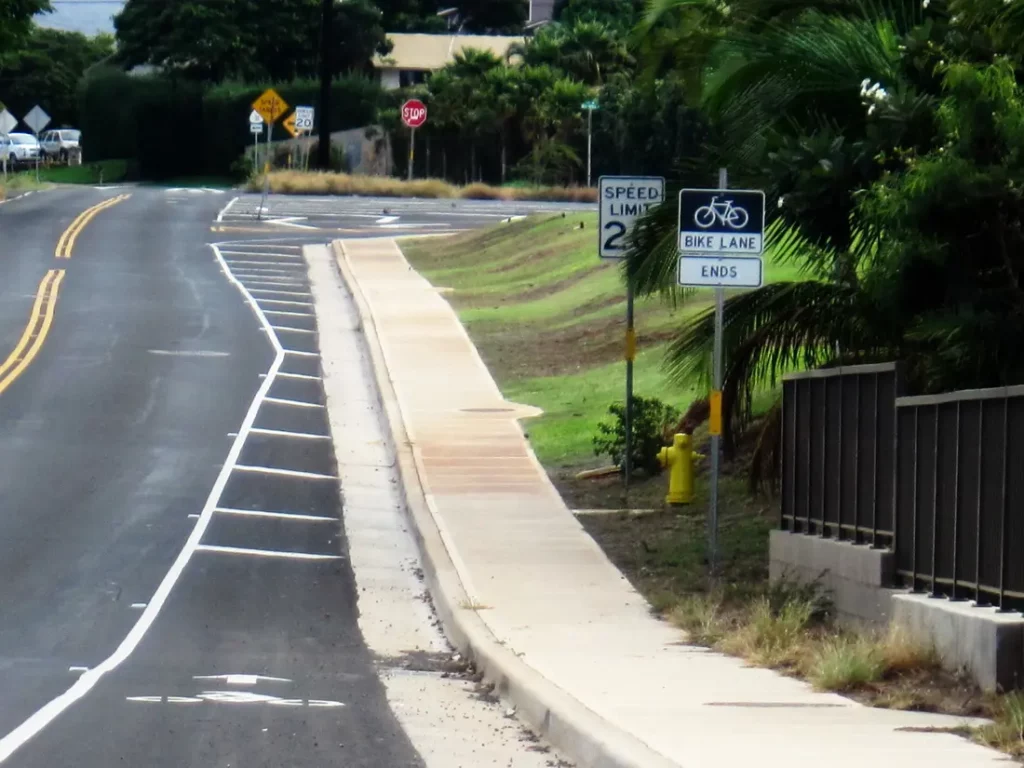
Kihei is a beachside town with a laid-back vibe, and many of the shops, restaurants, and accommodations are within walking distance of each other. Visitors can take a leisurely stroll along the beach, or explore the numerous parks and green spaces in the area. The town is relatively flat and is easy to navigate on foot, with several pedestrian-friendly streets and sidewalks. Visitors can explore several walking trails that take them along Kihei’s beautiful coastline, including the Wailea Beach Path and the Kihei Coastal Trail.
Paia: cute seaside town made for walking
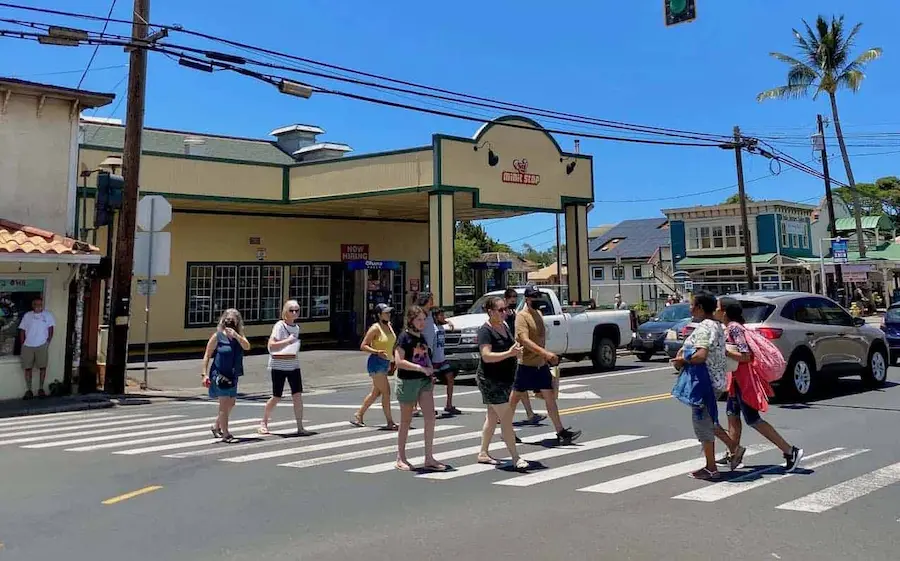
Paia is a bohemian town with a thriving arts scene, and visitors can explore the many galleries and boutiques on foot. The town is relatively small and is easy to explore on foot, with several pedestrian-friendly streets and sidewalks. Visitors can explore Paia’s charming downtown area, which features several shops and restaurants, as well as several nearby beaches containing trails, including Baldwin Beach Park and Ho’okipa Beach Park.
Kahului: sprawling city
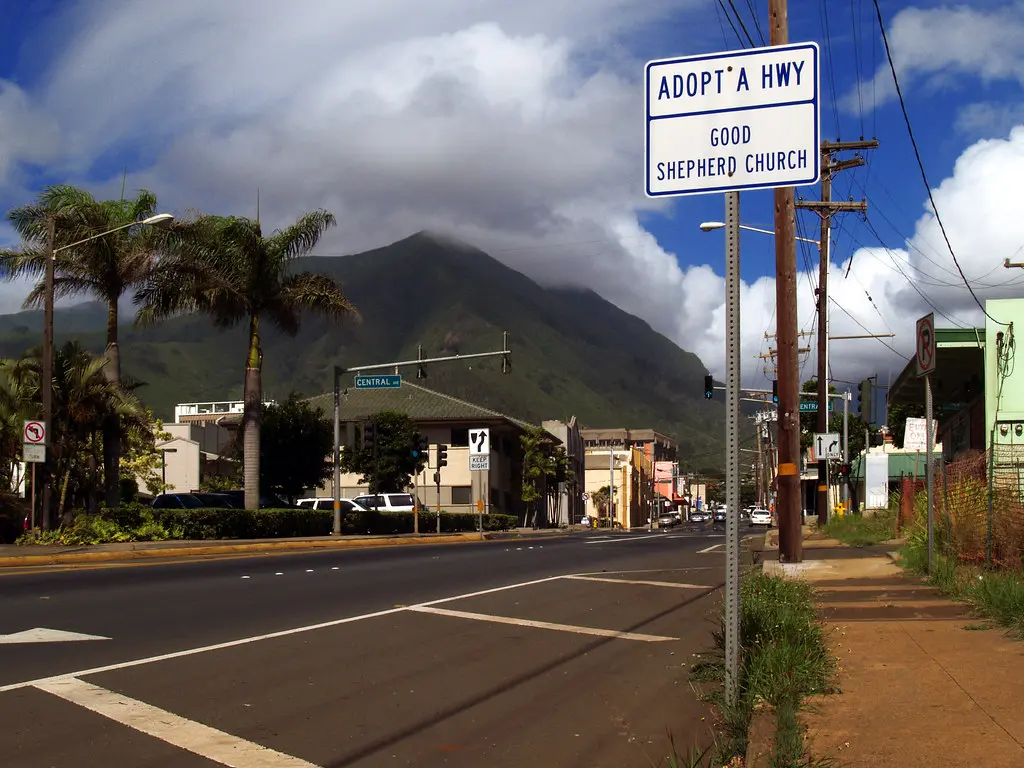
Kahului is the commercial center of Maui, with many shops and restaurants located within walking distance of each other. Visitors can explore the Maui Mall and the Queen Ka’ahumanu Center, or take a stroll through the Maui Arts and Cultural Center. While some areas of Kahului are walkable, the town is generally spread out and can be difficult to navigate on foot. Visitors should stick to the downtown area, which features several pedestrian-friendly streets and sidewalks, as well as several nearby attractions, including the Maui Arts and Cultural Center and the Kanaha Pond State Wildlife Sanctuary.
Wailea: posh resort area, spread out
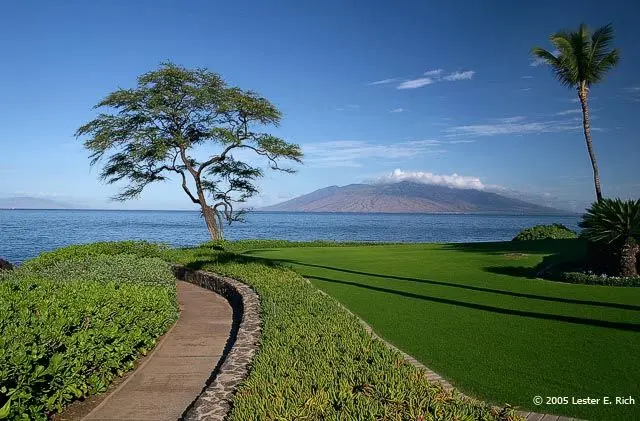
Wailea is a resort area with many high-end accommodations, restaurants, and shops. While some areas of Wailea are walkable, the resort area is generally spread out and can be difficult to navigate on foot. Visitors should stick to the Wailea Beach Path, which is a pedestrian-friendly walking trail that takes visitors along the coast and offers stunning views of the ocean and nearby islands.
Kapalua: sprawling resort area
Kapalua is a luxury resort area with many walking trails and access to several beaches. Visitors can explore the Kapalua Coastal Trail, which offers views of the Pacific Ocean and the neighboring islands. While some areas of Kapalua are walkable, the resort area is generally spread out and can be difficult to navigate on foot. Visitors should stick to the Kapalua Coastal Trail, which is a pedestrian-friendly walking trail that takes visitors along the coast and offers stunning views of the ocean and nearby islands.
There are many maps available for walking trails in these areas, including those provided by the Maui Visitors Bureau and the Hawaii State Parks website. Visitors can also consult with local tour operators or rental shops for recommendations on the best walking trails in Maui.
Download a copy of the Maui Driving map here (pdf).
Tips for walking in Maui:
If you’re planning to walk in Maui, adhere to the usual basic considerations to help you make the most of your experience and ensure your safety.
- Choose comfortable shoes: Walking in Maui often involves uneven terrain and can be strenuous, so it’s important to wear comfortable, supportive shoes. Flip-flops and sandals are not recommended for extended walks unless you live in them.
- Stay hydrated: The tropical climate in Maui can make walking hot and uncomfortable, so it’s important to stay hydrated. Be sure to bring plenty of water with you, especially if you’re walking in more remote areas.
- Use sun protection: A hat and sunglasses can help protect your skin and eyes from the sun’s strong rays. You should also avoid walking during the hottest part of the day (typically midday) to minimize your sun exposure and heat exhaustion.
- Plan your route: This may seem basic, but before setting out on a walk, plan your route carefully and ensure that it’s safe and feasible, and let somebody know where you plan to walk. Avoid walking on busy roads without sidewalks, and be aware of any potential hazards along the way.
- Be aware of your surroundings: Stay alert and aware of your surroundings at all times, especially if you’re out walking by yourself. Keep an eye out for cars, bikes, and other pedestrians, and be mindful of any potential hazards such as uneven pavement or slippery surfaces. Do not walk in unfamiliar areas with earbuds in your ears.
- Respect local customs and traditions: When walking through Maui’s towns and villages, be respectful of local customs and traditions. Dress appropriately, avoid loud or disruptive behavior, and be mindful of any cultural practices or customs.
Alternative transportation options:
Walking isn’t the only way to explore Maui. Public transportation, car rentals, biking, and ride-sharing services are all popular options.
Conclusion:
Maui is a walkable destination, but the level of walkability varies depending on where you are on the island. I recommend renting a car and driving to each little town on the Island, and exploring each area by foot.
Whether you’re looking to get some exercise, experience Maui’s natural beauty, or immerse yourself in the local culture, walking is a great way to do it. I hope this article has provided you with the information you need to make the most of your walking experience in Maui.
Discovering Maui’s Walking Wonders: Is It Possible to Travel the Island by Foot? FAQs:
What should I bring and wear when walking in Maui?
Be sure to bring plenty of water, comfortable walking shoes, and a hat or sunglasses to protect yourself from the sun. Wear comfortable walking shoes and dress in light layers, as the temperature can vary throughout the day.
Are there any guided walking tours available in Maui?
Yes, there are several guided walking tours available on Maui. These tours offer a unique and informative way to explore the island’s natural and cultural attractions.
- Haleakala National Park Guided Tours – This tour takes visitors on a hike through the Haleakala Crater, the largest dormant volcano on Maui. Visitors will learn about the geology, flora, and fauna of the area and experience breathtaking views. The tour is led by a knowledgeable guide and lasts approximately 3-4 hours.
- Lahaina Historic Walking Tour – This tour takes visitors on a stroll through the historic town of Lahaina, which was once a bustling whaling village. Visitors will learn about the town’s history, architecture, and culture while visiting landmarks such as the Lahaina Courthouse, the Baldwin Home Museum, and the Wo Hing Temple Museum.
- Maui Ocean Center Guided Tour – This tour takes visitors on a behind-the-scenes look at the Maui Ocean Center, which is home to thousands of marine animals. Visitors will learn about the center’s conservation efforts, as well as the behavior and biology of the animals that live there.
- Iao Valley Guided Tour – This tour takes visitors on a hike through the lush Iao Valley, which is home to the Iao Needle, a 1,200-foot rock formation. Visitors will learn about the area’s history and significance, as well as the native plants and animals that live there.
Are there any walking tours that focus on food or drink in Maui?
Yes, there are several walking tours in Maui that focus on food and drink, including tours of local farms, breweries, and wineries.
Can I walk to all the major tourist attractions on Maui?
No, some attractions are located in remote areas that are not easily accessible by foot. It’s best to research the specific attractions you want to visit and plan accordingly.
Are there any hiking trails in Maui?
Yes, there are several hiking trails in Maui that offer scenic views of the island’s natural beauty. However, some trails can be challenging and require a certain level of fitness and experience, so it’s important to research the trail before embarking on it.
Can I walk to the beach in Maui?
In some areas, depending on your accommodations, yes. However, many of the popular beaches on Maui are located near hotels and resorts, and if you are not staying at these resorts, some of the beaches are not be easily accessible on foot. It’s best to research the beach you want to visit and plan accordingly.
Are there any walking events or races held in Maui?
Yes, there are several walking events and races held in Maui throughout the year, including the Maui Oceanfront Marathon (5k to marathons).
What is the best time of day to walk in Maui?
The best time of day to walk in Maui is early in the morning or late in the afternoon when temperatures are cooler. It’s also a good idea to avoid walking during the hottest part of the day, which is typically between 11:00 AM and 3:00 PM.
Can I walk to the top of Haleakala?
Yes, visitors can hike to the summit of Haleakala, but be prepared for the challenging terrain and high altitude. Visitors must obtain a permit to enter the park and hike to the summit.
How can I find the best walking routes in Maui?
There are several resources available for finding the best walking routes in Maui, including online travel guides, hiking and walking maps, and local tourism offices. It’s also a good idea to ask locals for their recommendations and insights into the best places to explore on foot.
Is it possible to walk from town to town in Maui?
Yes, it is possible to walk from town to town in Maui, but the distance between some towns can be quite far, even to bike. Unless you’re on Maui to break some records, your time is better spent enjoying the destination instead of taking hours to get from place to place. It’s best to research the specific towns you want to visit and plan accordingly, or consider taking a shuttle or public transportation if walking is not feasible and you don’t have a car.
Are there any pedestrian-only areas in Maui?
There are a few pedestrian-friendly but not pedestrian-only areas in Maui, including the Lahaina Front Street and the Paia Town Center. These areas offer a unique and enjoyable walking experience with wide boardwalks and plenty of hustle and bustle (while still somehow retaining a relaxing atmosphere).
Is it safe to walk alone in Maui? What are some safety tips for walking in Maui?
While Maui is generally a safe destination, it’s important to take precautions as you would anywhere else. Some safety tips for walking in Maui include being aware of your surroundings, sticking to well-lit and pedestrian-friendly areas, and avoiding walking alone at night. It’s also important to carry a mobile phone with you and let someone know where you’re going.
Are there any walking trails that are suitable for families with children?
There are several walking trails in Maui that are suitable for families with children, including the Kapalua Coastal Trail. It’s important to research the trail beforehand and ensure that it is suitable for your family’s fitness level and experience.
Are there any walking trails that are wheelchair accessible?
There are several walking trails in Maui that are wheelchair accessible, including the Kealia Pond National Wildlife Refuge and the Lahaina Historic Trail.
Can I rent bicycles or scooters to explore Maui?
There are several rental companies in Maui that offer bicycles and scooters for rent.
Are there any guided walking tours that focus on Maui’s history and culture?
Yes, there are several guided walking tours in Maui that focus on the island’s rich history and cultural heritage, including tours of historic towns like Lahaina and guided nature walks in Haleakala National Park.
What is the weather like for walking in Maui?
The weather in Maui is generally warm and sunny, but temperatures can vary depending on the time of year and the location on the island. Dress in layers for the weather and wear a bathing suit underneath if you feel like taking a dip in a waterfall or the ocean. The weather in Maui is generally warm and sunny, making it a great destination for walking year-round, but visitors should be aware of the potential for rain or high winds in certain areas, particularly during the winter months.
Can I bring my dog with me when walking in Maui?
While some walking trails in Maui allow dogs, research the specific trail ahead of time and abide by local regulations. Goes without saying but I’m saying it: dogs should also be kept on a leash and owners should clean up after their pets.
Are there any walking trails that offer views of Maui’s waterfalls?
Yes, there are several walking trails in Maui that offer scenic views of the island’s waterfalls, including the Pipiwai Trail in Haleakala National Park and the Waihee Valley Trail.
What are some of the most popular walking trails in Maui?
Some of the most popular walking trails in Maui include the Kapalua Coastal Trail, the Waihee Ridge Trail, and the Pipiwai Trail in Haleakala National Park. The latter two are actually hikes, not so much strolls.
Can I walk on the beaches in Maui?
Yes, visitors are permitted to walk on most of the beaches in Maui. However, it’s important to be aware of local regulations and respect private property.
Should I rent a car when visiting Maui?
Renting a car is a popular option for visitors to Maui, as it offers more flexibility and convenience when exploring the island. As anywhere, traffic can be congested in certain areas, particularly during peak tourist season. Visitors should also be prepared to navigate winding roads and steep inclines, particularly on the Road to Hana. It’s recommended to make reservations in advance and to familiarize yourself with local traffic laws and regulations before renting a car.
While Maui may not be completely walkable, there are still many areas that can be explored on foot. With proper planning and awareness of safety considerations, visitors can enjoy a variety of walking opportunities, from scenic coastal trails to urban exploration.

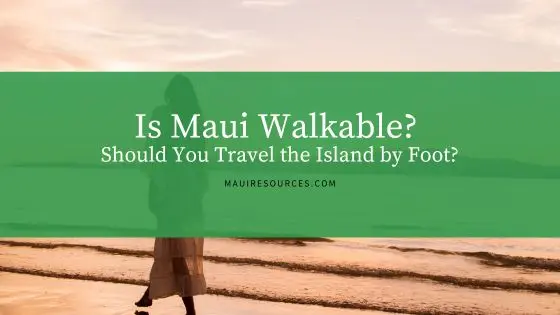

One thought on “Is Maui Walkable? Is It Possible to Travel the Island by Foot?”